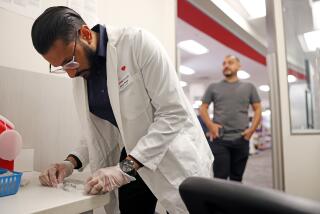The coronavirus has changed since it left Wuhan. Is it more infectious?
A version of the coronavirus first seen in Italy four months ago has overtaken the original strain from Wuhan, China, and is now dominant around the world, scientists reported Thursday.
The newer version has a mutation that alters the so-called spike protein the virus uses to enter human cells. The team of scientists who found it say the change probably makes the virus more infectious, which would explain why it was able to overtake its predecessor from China.
However, independent researchers said that assessment was premature and cited other factors that could explain its rapid spread.
By May 18, the version from Italy accounted for 78% of the 12,194 coronavirus samples that had been collected around the world in the previous six weeks, the study authors reported. Before March 1, by contrast, only 10% of the 997 samples available at that time carried the mutation.
Laboratory experiments showed that viruses with the spike mutation copied themselves more readily than those that lacked it. And in a sample of 999 COVID-19 patients in England, those who were infected with the Italian variant had higher viral loads — a correlation found by other research groups as well.
Even so, the patients with the newer coronavirus variant were no sicker than the patients with the earlier version of the virus.
The findings were published in the journal Cell.
The study authors, led by Bette Korber, a computational biologist at the Los Alamos National Laboratory, posted a preliminary version of the work in May that generated substantial controversy by claiming the mutation in the spike protein made the virus more contagious. Korber and her team also warned that the mutation could undermine efforts to develop desperately needed vaccines and treatments for COVID-19.
Other scientists challenged those conclusions, however, saying the analysis failed to show that the mutation played any role in fueling the virus’ spread or that it made the virus more difficult to control.
Cells hijacked by the coronavirus grow long, streaming tentacles to reach out to new victims, scientists found. This could complicate the search for a vaccine.
In principle, mutations in the coronavirus genome could complicate the search for effective drugs or vaccines. Viruses accumulate random mutations when they make mistakes copying themselves, and any one of those mistakes has the potential to alter the virus in a way that would render a pharmaceutical agent useless.
That’s why Korber and her colleagues devised a way to look for changes in the coronavirus genome — in particular, the genes responsible for the spikes that stud the coronavirus and give it its crown-like appearance.
“We have designed bioinformatic tools to create an ‘early warning’ strategy to evaluate Spike evolution during the pandemic,” they wrote.
Their system examines thousands of SARS-CoV-2 genomes from around the world that have been added to a database maintained by the Global Initiative for Sharing All Influenza Data, or GISAID. The Los Alamos software flags genomes whose instructions for making the spike proteins vary from the original Wuhan sequence by 0.3% or more.
If a particular variant turns up with increasing frequency in different parts of the world, it could be giving the virus some kind of evolutionary advantage that vaccine and treatment developers ought to know about, they wrote.
The first suspicious mutation their system turned up causes a change in one of the amino acids that make up the spikes. Today, that mutation is “almost always” found alongside three other mutations elsewhere in the genome, the researchers wrote.
This version of SARS-CoV-2 was detected in Italy on Feb. 20. “Within days,” the team wrote, it “was sampled in many countries in Europe.”
During the month of March, it spread in North America, South America, Europe, Asia and Oceania, and by month’s end it was the dominant version in all those continents except for Asia. The team also examined 17 individual countries and found that this version gained ground in 16 of them.
The exception was Iceland. But that might have been because at the beginning of the month, the majority of people tested were travelers from Europe; by mid-March, locals were being screened and their samples included in the testing pool.
There was one other place where the Wuhan coronavirus held its own against the version from Italy: Santa Clara County. Samples taken by the Santa Clara Department of Public Health suggest that, with the exception of Stanford University, the newer version didn’t show up in the community until June.
But overall, they concluded, “the speed with which [the Italian version of the virus] became the dominant form globally suggests the need for continued vigilance.”
Despite President Trump’s statements that the coronavirus was released from a laboratory in Wuhan, scientists say the evidence points to a natural origin.
In a commentary that accompanies the study, three scientists from Yale, Harvard and Columbia agreed that the mutation affecting the coronavirus spike protein is “now dominant in many places around the world.” But the significance of that is far from clear, they wrote.
For instance, they explained that the newer version could have become dominant in the United States because most of the people who brought the coronavirus here came from Europe (where the mutation was widespread), not China (where it was not).
Although the lab experiments showed that viruses with the spike mutation were able to infect cells in a dish, that doesn’t necessarily mean they’d be better at infecting people in the real world, the scientists added. As researchers learned during the Ebola epidemic, “it’s impossible” for tests in a lab to show that “a single mutation alone would have a major impact on a large, diverse human population.”
It’s also “unlikely” that the mutation will make the virus more resistant to drugs or vaccines, the authors of the commentary wrote. The change it brings about in the spike protein is not in the region that allows the virus to bind to a host cell.
What’s more, antibodies taken from COVID-19 survivors were able to neutralize both versions of the coronavirus. That suggests the change produced by the mutation doesn’t affect the body’s immune response.
Still, until scientists get a better handle on what — if any — effect the mutation has, researchers working on vaccines and treatments ought to keep it in mind as they go about their work, the scientistswrote.







